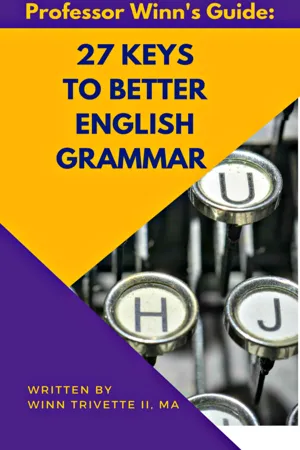
- English
- ePUB (mobile friendly)
- Available on iOS & Android
27 Keys to Better English Grammar
About this book
Study these 27 easily understandable English grammar lessons!
Professor Winn, a veteran English teacher, hand selects lessons that have frustrated his own students with big grammar doubts.
He created 27 Keys to Better English Grammar because he knows both students and professional need a resource that presents English grammar without the rigid rules of other textbooks.
Better English grammar should not be difficult!
Use the exercises after each lesson to check your understanding.
Well-designed and authoritative, both students and professionals can use this great resource for everyday use.
Indeed, 27 Keys to Better English Grammar is a reference, study aide for exams, or perfect classroom text.
From the present perfect simple to the past subjunctive and relative clauses (restrictive, non-restrictive) to verbs/adjectives/nouns and prepositions, start today to improve your English grammar!
Finally, take control and answer your serious questions about English grammar.
Avoid costly grammar mistakes in your letters, memos, or research papers today!
Frequently asked questions
- Essential is ideal for learners and professionals who enjoy exploring a wide range of subjects. Access the Essential Library with 800,000+ trusted titles and best-sellers across business, personal growth, and the humanities. Includes unlimited reading time and Standard Read Aloud voice.
- Complete: Perfect for advanced learners and researchers needing full, unrestricted access. Unlock 1.4M+ books across hundreds of subjects, including academic and specialized titles. The Complete Plan also includes advanced features like Premium Read Aloud and Research Assistant.
Please note we cannot support devices running on iOS 13 and Android 7 or earlier. Learn more about using the app.
Information
Key#1: Present Simple vs. Present Simple Continuous
Present Simple Usage
Present Simple Continuous Usage
Examples:
Exercise 1.1: Present Simple vs. Present Simple Continuous
1. Tate Associates _______(sponsor) the Special Olympics in London next year.
2. CEO Franz Guerner often ______ (give) a presentation to all of his employees at the end of the year.
3. Unemployment usually _____ (lag) behind exports after an economic recovery.
4. The price of cocoa _____(soar) on news of political instability in the Ivory Coast.
5. More government regulation_____ (hinder) the export of cotton, according to a recent economic study.
6. Marketing graduates _____(enjoy) a surge of popularity with the spread of social media in the corporate world.
7. A group of senior managers _____(resign) over the harsh pay cuts this quarter.
8. A team of consultants _____ (advise) the company chairman on the hiring and firing policy.
9. It seems the company’s stock _____ (decline) every time a new product is released on the market.
10.Jerrod _____ (fly) to Paris next Wednesday and ____ (stop by) the local office during his trip to Lyon.
11. Lynox Systems ____ (portray) its social investments in the community as a noble gesture for peace.
12. The new Internet-capable watch _____ (go) on sale this Friday at midnight.
Key #2: Past Simple vs. Present Perfect
Past Simple Usage
Present Perfect Usage:
Examples:
Exercise 2.1: Past Simple vs. Present Perfect Simple
Table of contents
- Title Page
- Copyright Page
- Dedication
- Why Buy This Book
- Key#1: Present Simple vs. Present Simple Continuous
- Key #2: Past Simple vs. Present Perfect
- Key #3: Present Perfect Simple vs. Present Perfect Progressive
- Key #4: Future Time
- Key #5: Comparative and Superlative Adjectives
- Key #6: Frequency Adverbs
- Key #7: Passive Voice
- Key #8: Connecting Ideas
- Key #9: Gerunds and Infinitives
- Key #10: Used to and Would
- Key #11: No, None (of), Nothing/Nobody
- Key #12: Modals: Ability, Requests, and Offers (CAN/COULD)
- Key #14: Noun Clauses
- Key #16: Third and Mixed Conditional
- Key #17: Verb + Preposition
- Key #18: Adjective + Preposition
- Key #19: Noun + Preposition
- Key #20: -ing Prepositions
- Key #21: Relative Pronouns and (Non) Restrictive Clauses
- Key #22: Discourse Markers
- Key #23: Present Subjunctive
- Key #24: Past Subjunctive
- Key #25: Causatives – Let / Make / Have / Get
- Key #26: Indirect Speech: Imperatives
- Key #27: Stative Verbs
- Bonus Lesson: Phrases to Show Contrast
- THANK YOU FOR READING
- Also By Winn Trivette II, MA



